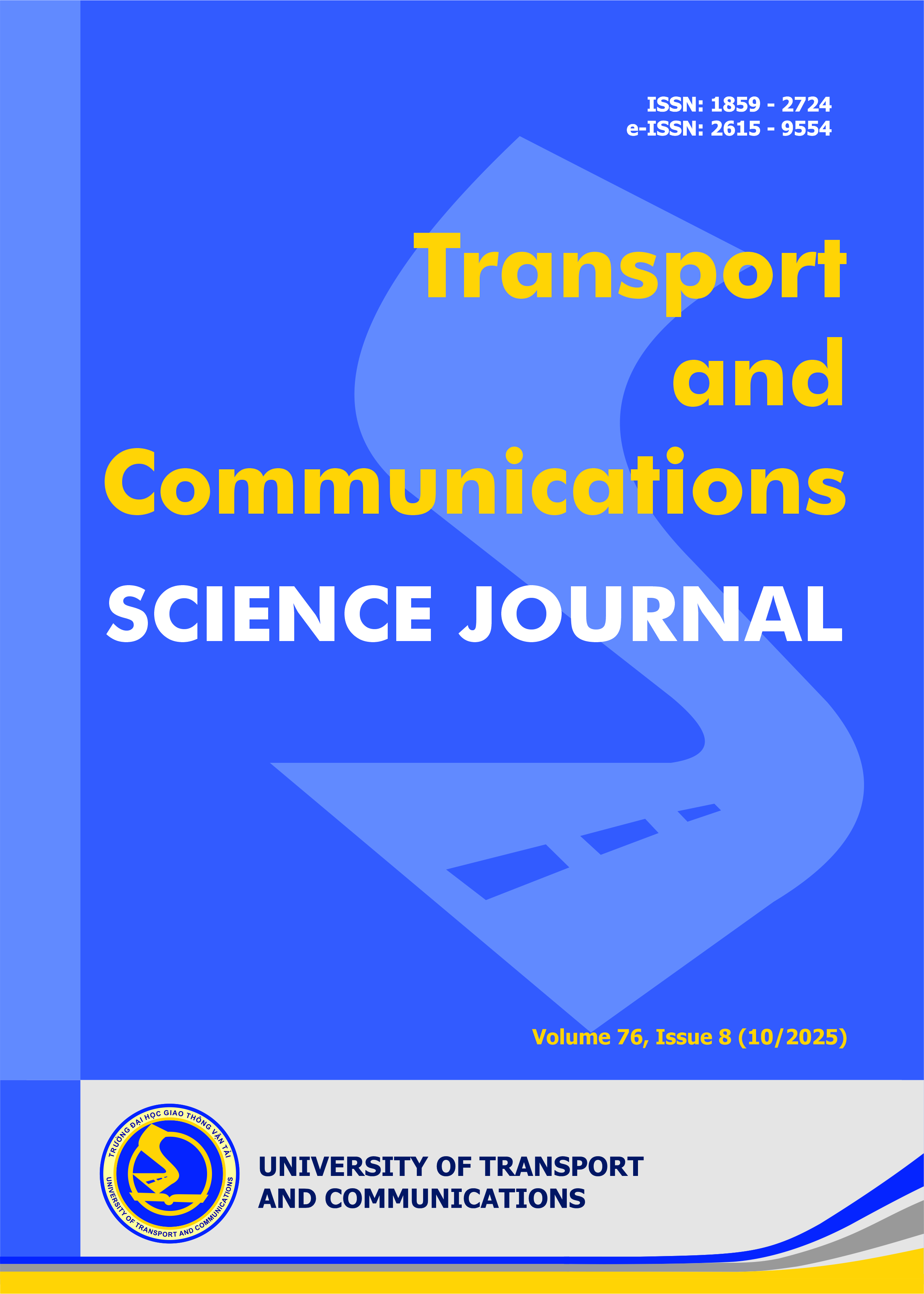Page(s): 1034-1048 Hung Nguyen Van, Van Nguyen ThanhAbstractCurrently, waterway transportation accounts for a significant share of global import and export trade. Additionally, high-voltage electrical equipment is increasingly being deployed on newly built ships to enhance their load capacity. However, working with high-voltage electrical systems poses potential hazards to crew members, requiring specialized skills and knowledge. This paper proposes the development of a realistic flashover voltage test model within a shipboard environment using the TERCO equipment. A model has been developed to evaluate and simulate high-voltage electrical safety training in accordance with IMO standards, utilizing Virtual Reality (VR) technology on the Unity 3D platform integrated with Artificial Neural Networks (ANN) and Bootstrapping techniques. This system enables crew members to engage in realistic and interactive training scenarios that enhance life safety awareness during high-voltage operations. Preliminary research results demonstrate significant advantages over conventional training methods, including enhanced realism and flexible scenario customization. Evaluation of crew performance using the system indicates a training effectiveness rate of 90 %, effectively fulfilling the core requirements for high-voltage electrical safety training among crew members
Page(s): 1049-1063 Hung Nguyen VuAbstractThe vibration behavior of structures under explosive loads, especially plates with non-uniform thickness made of functionally graded materials (FGMs), has become a prominent topic in modern engineering mechanics. In this study, a finite element method combined with the direct Newmark integration scheme based on the first-order shear deformation theory is developed to analyze the forced vibration of FGM plates with variable thickness subjected to blast-induced shock waves. The plate thickness varies nonlinearly in both in-plane directions, while the material properties are graded along the thickness direction. The accuracy of the proposed model and method is verified by comparison with results from reputable published studies. Subsequently, numerical investigations are conducted to evaluate the effects of key parameters such as blast amplitude, wave propagation speed, material gradient index, and thickness variation coefficients on the dynamic response of the plate. The findings offer significant insights for the structural design and safety assessment of FGM plates exposed to explosive loading
Study of the stress state, deflection, and vibration of cracked concrete plates
Page(s): 1064-1077 Phuc Pham Minh, Dung Mai Anh, Du Nguyen DinhAbstractThe Portland cement concrete (PCC) plates in transportation infrastructure and floor systems commonly develop cracks due to repeated loading, shrinkage, and environmental effects, which reduce stiffness, increase deflection, and alter dynamic characteristics. Accurate modeling of the stress state, deflection, and vibration is therefore essential for assessment and strengthening design. This paper presents a unified computational framework for cracked PCC plates that combines the first-order shear deformation theory (FSDT) to represent moderately thick plate behavior, a phase-field model to describe a continuous crack field without explicit crack-front tracking, and the finite element method (FEM) for static bending and free-vibration analyses. The model is validated against reputable studies (deflection of PCC plates, responses of cracked plates, and the relationship between cracking and natural frequencies), and then used for a parametric study with respect to crack length, crack inclination angle, boundary conditions, and thickness ratio. The results show that edge stresses and stresses in the crack-tip vicinity increase markedly, and the stress/deflection fields depend strongly on crack length and boundary conditions. The mid-plate deflection and natural frequencies decrease monotonically as crack length increases, whereas the influence of crack orientation is secondary compared with crack length for the cases investigated
Page(s): 1078-1092 Anh Bui Tuan, Phuc Nguyen Quang, Phuc Pham MinhAbstractCurrently, asphalt pavement design in Vietnam largely relies on empirical standards, with limited analysis of the aggregate base layer's performance impact. This study investigates the role of the crushed stone base (CSB) in asphalt pavement structures using a mechanistic-empirical approach via the AASHTOWare Pavement ME Design software. By analyzing a wide range of pavement configurations with varying CSB thicknesses, subgrade modulus, and base modulus, the study evaluates their influence on performance indicators such as rutting (RD-T), surface roughness (IRI), bottom-up cracking (FC-BU), top-down cracking (FC-TD), and surface layer rutting (RD-AC). Results show that increasing CSB thickness yields optimal benefits at 300–400 mm, beyond which the effect diminishes. Subgrade modulus significantly impacts IRI and RD-T, while base modulus has a strong influence on FC-BU. The study demonstrates that applying a mechanistic-empirical framework can enhance pavement structure optimization and material efficiency, especially under Vietnamese conditions
Page(s): 1093-1107 Phuc Nguyen Quang, Dung Chu TienAbstractCold in-place recycling (CIR) with foamed bitumen and cement has attracted attention thanks to its ability to save materials, reduce emissions, and align with the goal of sustainable infrastructure development. Although it has been applied in Vietnam, systematic studies evaluating its effectiveness under tropical monsoon conditions and heavy traffic overloading are still lacking. This paper presents experimental results on five national highways in Central and Southern Vietnam, including field surveys, laboratory tests, recycled mix design, and post-construction elastic modulus measurements. The results show that all recycled mixtures satisfied technical requirements, with post-construction elastic modulus values 10–58% higher than the design values, demonstrating the ability to enhance the durability and load-bearing capacity of the pavement structure. The novelties of this study are: (i) providing the first multi-project experimental dataset in Vietnam, (ii) verifying the effectiveness of the technology through comparison between mix design results and actual measurements, and (iii) adding scientific evidence from tropical and overloaded traffic conditions, thereby contributing to expanding international knowledge on CIR technology in the context of developing countries
Physics-informed neural network modeling of a bar under pure axial tension: an efficient framework
Page(s): 1108-1122 Loan Bui Thi, Viet Tran Bao, Quan Nguyen Hoang, Thuy Pham Thi Thanh, Mai Bui Thi ThanhAbstractIn structural mechanics, solving partial differential equations (PDEs) is traditionally performed using numerical methods such as the Finite Element Method (FEM). However, when applied to optimization problems, FEM often encounters limitations due to its high computational cost and difficulties in handling continuously varying geometries. Recently, Physics-Informed Neural Networks (PINNs) have emerged as a promising alternative, enabling the solution of PDEs without mesh generation by directly embedding physical laws into the loss function of deep learning models. This study initially develops a PINN model for the uniaxial tension bar problem, with the aim of evaluating the effectiveness of three commonly used training techniques: non-dimensionalization of input and output variables; the use of hard versus soft boundary conditions; and the choice between PDE-based and energy-based loss functions. Results show that non-dimensionalization improves accuracy by balancing gradients across physical quantities; hard boundary conditions lead to faster and more stable convergence; and PDE-based loss functions enforce local physical constraints more effectively than energy-based ones. This work represents only an initial study on a simple problem; nevertheless, the obtained results demonstrate the potential of PINNs in structural mechanics and provide a foundation for further development and extension to more complex problems
Page(s): 1123-1137 Canh Le Minh, Chuyen Nguyen Duc, Sang Le ThanhAbstractDuring the operational phase, reinforced concrete (RC) box-girder bridges are significantly influenced by environmental temperature variations. Temperature differentials among different parts of the cross-section generate considerable thermal stresses, reducing structural durability and lifespan. Recent studies highlight substantial discrepancies between vertical thermal gradients measured in the field and the standard values prescribed by the Vietnamese standard TCVN 11823:2017. This study analyzes nearly three years of continuous temperature measurement data from three representative bridges located in distinct climatic regions of Vietnam: Vinh Thinh Bridge (Northern region), Quan Hau Bridge (Central region), and Go Gang Bridge (Southern region). To enhance the accuracy of thermal effect assessments, supervised machine learning models including Linear Regression, Boosted Tree, Random Forest, XGBoost, and Artificial Neural Network (ANN) were developed to predict critical thermal gradient values. Among these models, the ANN demonstrated superior performance, achieving coefficient of determination (R2) above 0,70 for both MAX-Gy and MIN-Gy. This result indicates strong predictive capabilities and effectiveness in capturing nonlinear relationships between meteorological conditions and the geometric characteristics of bridge cross-sections. The outcomes provide a robust scientific foundation for the design, evaluation, and maintenance of RC box-girder bridges in tropical climates, ultimately contributing to increased durability and operational efficiency
Page(s): 1138-1150 Cong Tran Duc, Huong Ho Thi Lan, Giang Le Khanh, Hien Le VanAbstractGNSS-RTK satellite positioning technology has been widely applied in structural health monitoring (SHM) of cable-stayed bridges due to its ability to provide accurate and continuous displacement data. However, a major challenge is that the monitoring data often contain noise, outliers, and lack labels, which makes early detection of abnormal structural states difficult. This study focuses on analyzing vertical GNSS-RTK displacement time series from the Nhat Tan cable-stayed bridge (Hanoi) using two unsupervised clustering algorithms: Hierarchical Agglomerative Clustering (HAC) and the Gaussian Mixture Model (GMM). The analysis procedure includes data preprocessing (outlier removal using the Hampel filter, interpolation, segmentation, and z-score normalization) and cluster validation through the Silhouette index. The results show that both HAC and GMM identify the optimal number of clusters as k = 2, representing two distinct displacement states, with GMM achieving better clustering performance (Silhouette ≈ 0.596) compared to HAC (≈ 0.520). These findings confirm the feasibility of applying unsupervised clustering for early detection of abnormal states in cable-stayed bridges, thereby enhancing proactive maintenance efficiency and operational safety










